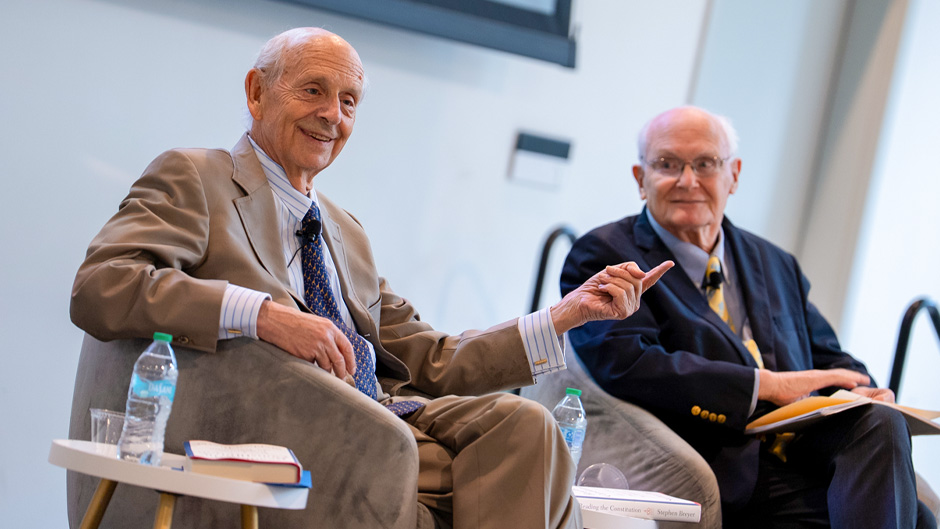During his nearly three decades on the U.S. Supreme Court, Justice Stephen Breyer issued a multitude of majority opinions and dissents, ruling on cases that involved everything from abortion and the Ten Commandments to the death penalty and school desegregation.
But even though he stepped down from the high court three years ago, the Harvard-educated lawyer is still making a case, arguing against textualism and originalism—the dominant approach taken by jurists who rely on a strict interpretation of the Constitution—in favor of a more pragmatic method to elucidating the document.
Sunday, using the trademark anecdotes, humor, and hypothetical scenarios for which he is known, Breyer brought his case to the University of Miami campus, where, during a fireside chat with former Miami Herald publisher David Lawrence Jr., he analyzed the different types of constitutional interpretation, recalled some of the Supreme Court cases on which he ruled, and doled out advice to the more than 100 students from the University’s School of Law who attended.
Sponsored by Books & Books in collaboration with the School of Law, the event celebrated Breyer’s new book, “Reading the Constitution: Why I Chose Pragmatism, Not Textualism.”
During his hour-long talk inside the Lakeside Village Expo Center, Breyer, who views the Constitution as a “workable” document to be interpreted by future generations, warned that textualism and originalism will result in a Constitution “nobody wants.”
To illustrate the challenges judges often face in interpreting and applying the law, Breyer recounted the time he was in France and read a newspaper story of a biology teacher who was taking a train from the city of Nantes to Paris with 20 live snails in a basket.
“Do you have a ticket for the snails,” a conductor asked the teacher, pointing out that the fare book required that animals travel for the cost of a half-price ticket.
The biology teacher was astounded. Surely, that rule didn’t apply to snails.
“Well, they are animals, are they not?” the conductor said.
While amusing and entertaining, Breyer’s anecdote epitomized the nature of weightier decisions appellate courts and judges are often asked to make.
Breyer, who was nominated to the Supreme Court by President Bill Clinton in 1994, told students that, while as lawyers, they will aspire to be as objective as possible, it is inevitable that their personal experiences and identity will influence their decisions on cases.
“You can’t help but be influenced by the way you were brought up,” Breyer said. “I’ve lived the life I’ve led and so have you. And you will, whether you’re in your 40s or 50s, be influenced by that. You can’t jump out of your own skin. You can try to keep your own experiences out of it, but you’ll never succeed in doing it.”
He recounted some of the Supreme Court cases in which he ruled, including Dobbs v. Jackson Women’s Health Organization, the 2022 case that overturned Roe v. Wade and Planned Parenthood v. Casey, rescinding the constitutional right to a legal abortion.
Breyer co-wrote a dissenting opinion in that case, joining liberal Justices Sonia Sotomayor and Elena Kagan in arguing that the decision curtailed women’s rights and “their status as free and equal citizens.”
The conservative majority, Breyer said, ruled that they overturned Roe v Wade because, in their view, “it was egregiously wrong, very wrong.”
“But how do you know it’s wrong?” Breyer asked rhetorically during his Sunday fireside chat.
Breyer signed copies of his book after the event, with the line inside the Expo Center stretching nearly the length of the room.
First-year law student Cradler Volmar found Breyer's remarks on oral advocacy to be the most compelling portion of the talk.
“He stressed that, in appellate arguments, judges have already read the attorney’s briefs and arguments, so advocates should spend less time explaining their argument and more time addressing the weak points of the opposing party,” Volmar said. “This translates directly to my law school journey and subsequent career. We are being trained to analyze information in such a way that makes our argument more persuasive than our opposition’s. Further, Justice Breyer's comment on this point highlights the reason I and many of my peers chose to go to law school in the first place—the opportunity to use our analytical skills to form an argument that achieves the desired result.”
Second-year law student Tori Vasquez, a member of the Charles C. Papy, Jr. Moot Court Board and of the Yvette Ostolaza Mock Trial Team at the law school, said “it was interesting to hear Justice Breyer speak about the intention that he employed in his methodology. He mentioned thinking about the Constitution of the future and how justices may best apply the laws that will impact society. This is particularly important in law school because we are working toward building our knowledge to contribute to the future legal community.”
The event came a little more than five months after Ketanji Brown Jackson, the first Black woman to serve on the Supreme Court who replaced Breyer just as he was retiring, spoke on the University’s Coral Gables Campus.
“This is exactly what universities do,” Patricia Abril, interim dean of the School of Law, said of the Breyer event. “Bringing together members of the community, the judiciary, academia, students, friends, and family to experience three things that we all love and champion: books, law, and dialogue. It’s magical.”

